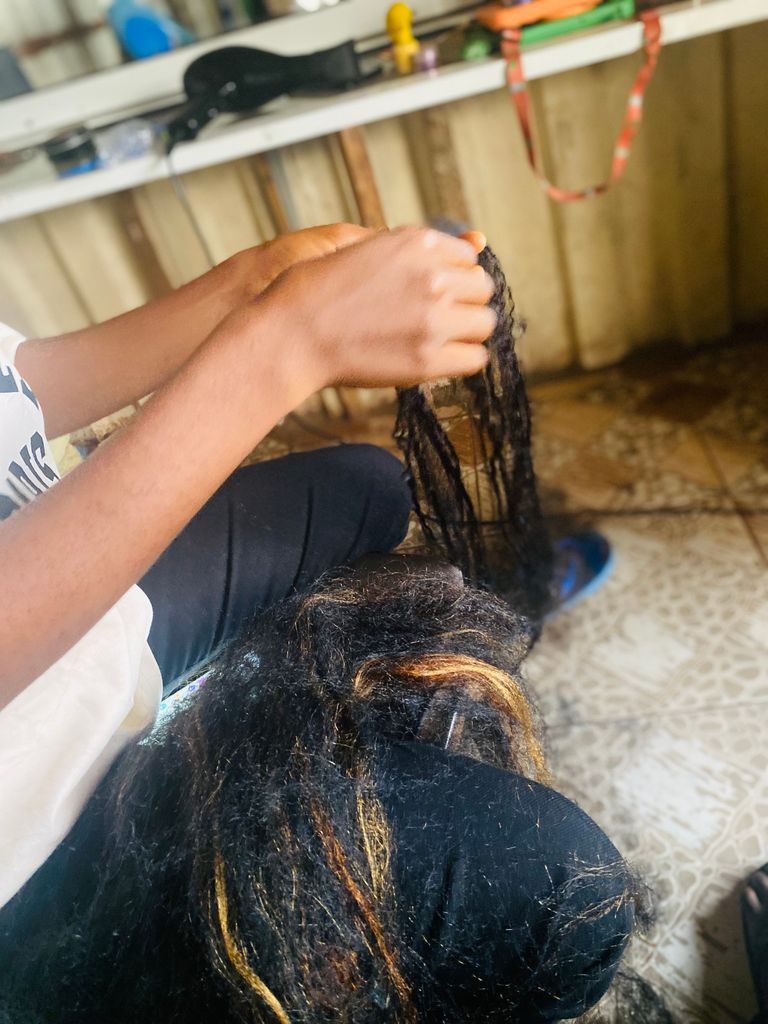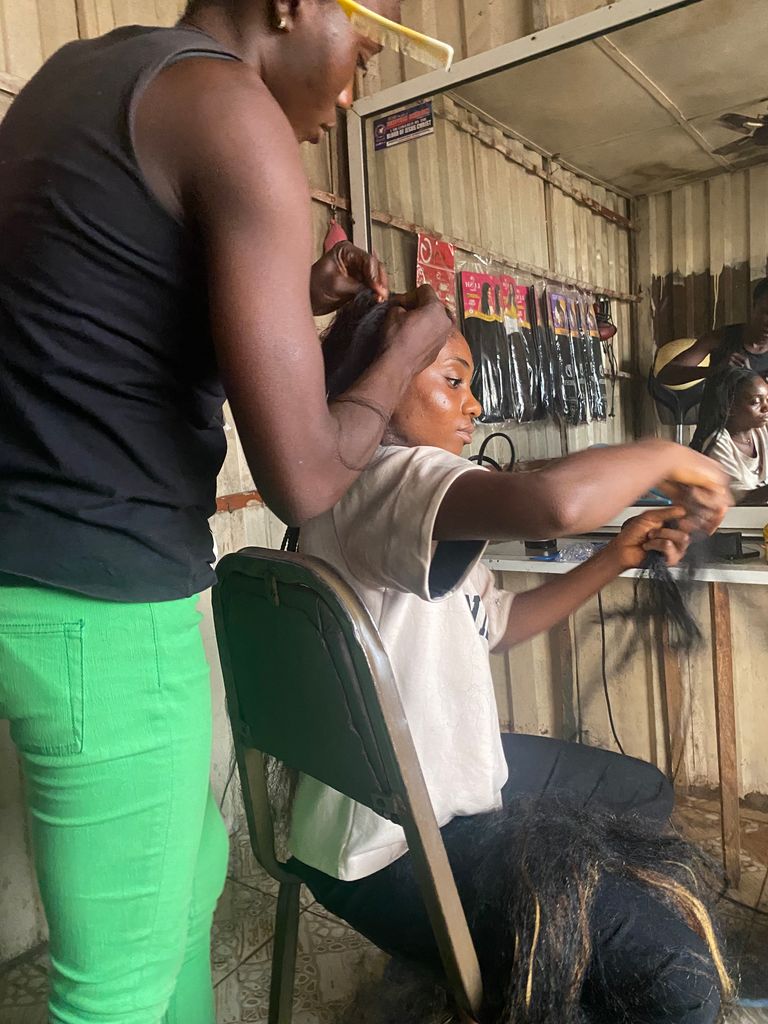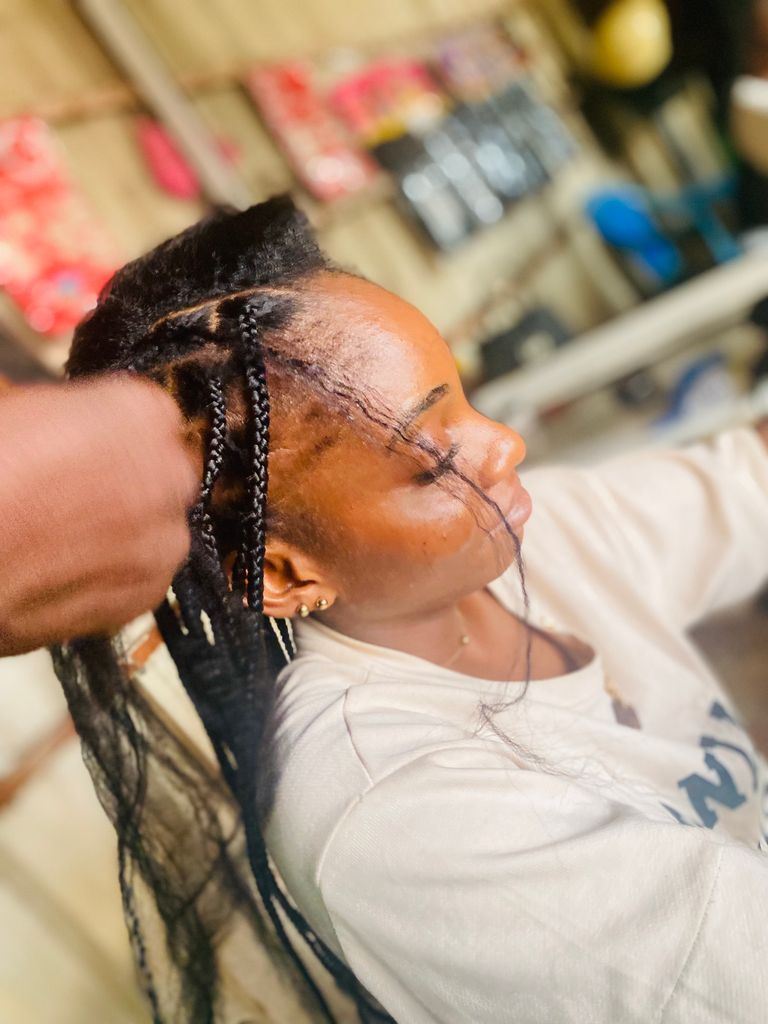
Hand job skills has been the best means of survival for Nigerias as there’s no job in Nigeria, for you to be able to have a white collar job in nigeria you must need connection to get a good job, so the Nigerian citizens gets to learn a hand job skills like barbing, hairdressing etc so that they can meet earns means for them selves and their families. Yesterday been Sunday I escorted my friend to her friends saloon to make her hair and I took some pictures of her and her hairstyle.
A hair stylist is a professional who specializes in cutting, coloring, and styling hair. They use their skills and creativity to enhance the appearance of their clients, making them look and feel their best.
Types of Hair Stylists:
- Salon Stylist: Works in a salon, providing a range of services including cuts, colors, and styles.
- Freelance Stylist: Works independently, traveling to clients' homes or locations to provide hair services.
- Celebrity Stylist: Specializes in styling hair for celebrities, often working on film and television sets, photo shoots, and red carpet events.
- Editorial Stylist: Creates hairstyles for editorial photo shoots, fashion shows, and other high-end events.
- Bridal Stylist: Specializes in styling hair for weddings and other special occasions.
Services Offered by Hair Stylists:
- Hair Cuts: Cutting and trimming hair to achieve a desired style or shape.
- Hair Color: Applying color to hair to enhance or change its natural color.
- Hair Styling: Using various techniques to style hair, including blow-drying, flat ironing, and curling.
- Updos: Creating hairstyles that involve pulling hair up and away from the face, often for special occasions.
- Extensions: Adding hair extensions to enhance the length, volume, or color of hair.
Skills and Qualities of a Good Hair Stylist:
- Creativity: Ability to think creatively and come up with unique and stylish ideas.
- Attention to Detail: Ability to pay close attention to detail, ensuring that every aspect of the hairstyle is perfect.
- Communication Skills: Ability to listen to clients and understand their needs and preferences.
- Technical Skills: Proficiency in various hair cutting, coloring, and styling techniques.
- Time Management: Ability to manage time effectively, ensuring that appointments are completed on schedule.
Education and Training:
- Cosmetology School: Completing a program in cosmetology to learn the fundamentals of hair cutting, coloring, and styling.
- Apprenticeships: Working under the guidance of an experienced stylist to gain hands-on experience.
- Continuing Education: Attending workshops, seminars, and online courses to stay up-to-date with the latest trends and techniques.
Career Path:
- Assistant Stylist: Starting as an assistant to an experienced stylist, learning the ropes and gaining experience.
- Junior Stylist: Working as a junior stylist, taking on more responsibility and building a client base.
- Senior Stylist: Becoming a senior stylist, leading a team and taking on more complex and high-end clients.
- Salon Owner: Opening and running a successful salon, managing a team and building a reputation as a top stylist.








Hand job skills refer to the abilities and techniques used to perform tasks that require manual dexterity, coordination, and attention to detail. These skills are essential in various industries, such as:
- Craftsmanship: Woodworking, carpentry, blacksmithing, and other trades that require working with hands to create or repair objects.
- Manufacturing: Assembly line work, quality control, and inspection, where hands are used to manipulate and examine products.
- Healthcare: Nursing, surgery, and other medical professions that require precise hand movements and dexterity to care for patients.
- Art and Design: Painting, drawing, sculpture, and other creative fields that rely on manual skills to produce artistic works.
- Technology: Electronics, robotics, and programming, where hands are used to assemble, repair, and operate devices.
Some common hand job skills include:
- Dexterity: The ability to perform tasks that require coordination and agility, such as playing a musical instrument or typing on a keyboard.
- Fine motor control: The ability to make precise movements with hands and fingers, such as threading a needle or assembling small parts.
- Grip strength: The ability to hold and manipulate objects with hands, such as lifting heavy objects or using power tools.
- Hand-eye coordination: The ability to coordinate hand movements with visual information, such as catching a ball or playing a sport.
- Tactile awareness: The ability to perceive and interpret sensory information through touch, such as identifying textures or temperatures.
To develop hand job skills, individuals can:
- Practice: Engage in activities that require manual dexterity, such as puzzles, crafts, or playing a musical instrument.
- Train: Participate in vocational training or apprenticeships to learn specific hand job skills.
- Exercise: Perform exercises that improve hand strength, flexibility, and coordination, such as finger stretches or grip strengthening exercises.
- Observe: Watch others perform tasks that require hand job skills and learn from their techniques.
- Experiment: Try new activities and tasks that challenge hand job skills, such as learning a new craft or playing a new sport.
Some examples of hand job skills in different industries include:
- Surgery: A surgeon's ability to perform precise incisions and sutures.
- Watchmaking: A watchmaker's ability to assemble and repair intricate timepieces.
- Carpentry: A carpenter's ability to cut, shape, and assemble wood to create furniture or buildings.
- Electronics: An electronics technician's ability to assemble and repair electronic devices, such as smartphones or computers.
- Art: A painter's ability to mix colors, apply brushstrokes, and create intricate details.


Thank you for stopping by my post today, I hope you enjoy my content please drop a comment below and state how useful this content was to you. Thank you for support

Congratulations, your post has been upvoted by @dsc-r2cornell, which is the curating account for @R2cornell's Discord Community.
Enhorabuena, su "post" ha sido "up-voted" por @dsc-r2cornell, que es la "cuenta curating" de la Comunidad de la Discordia de @R2cornell.